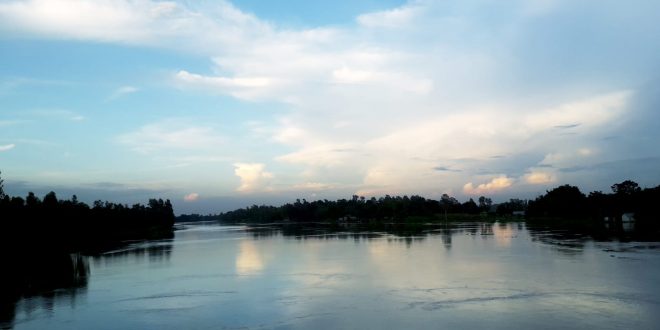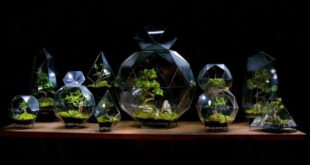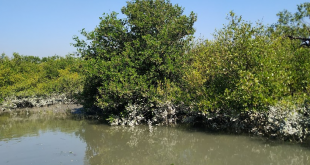Do you know what an ecosystem actually is! What is it’s types, components, threats towards it! In this article we are about to discuss all this stuffs.
An ecosystem is a community where living and nonliving material become mix-up. It can be a Geographical area where plants, animals and other organisms as well as soil, weather, water work together to form a life Bubble. It contains a biotic and abiotic parts of ecology. Ecosystem can be large or small. In short definition, An ecosystem is a community or group of living organisms that live in and interact with each other in a specific environment.
eg. Forest ecosystem, desert, river ecosystem, pond ecosystem, grassland ecosystem etc. The concept of Ecosystem was first used by A.G. Tansley in 1935. Ecosystem act as a fundamental unit of nature.
Best safe and secure cloud storage with password protection
Get Envato Elements, Prime Video, Hotstar and Netflix For Free
Best Money Earning Website 100$ Day
#1 Top ranking article submission website
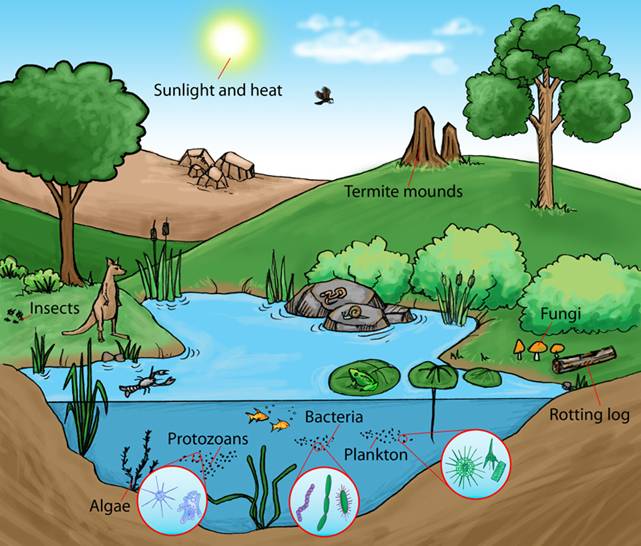
Classification of ecosystems
-
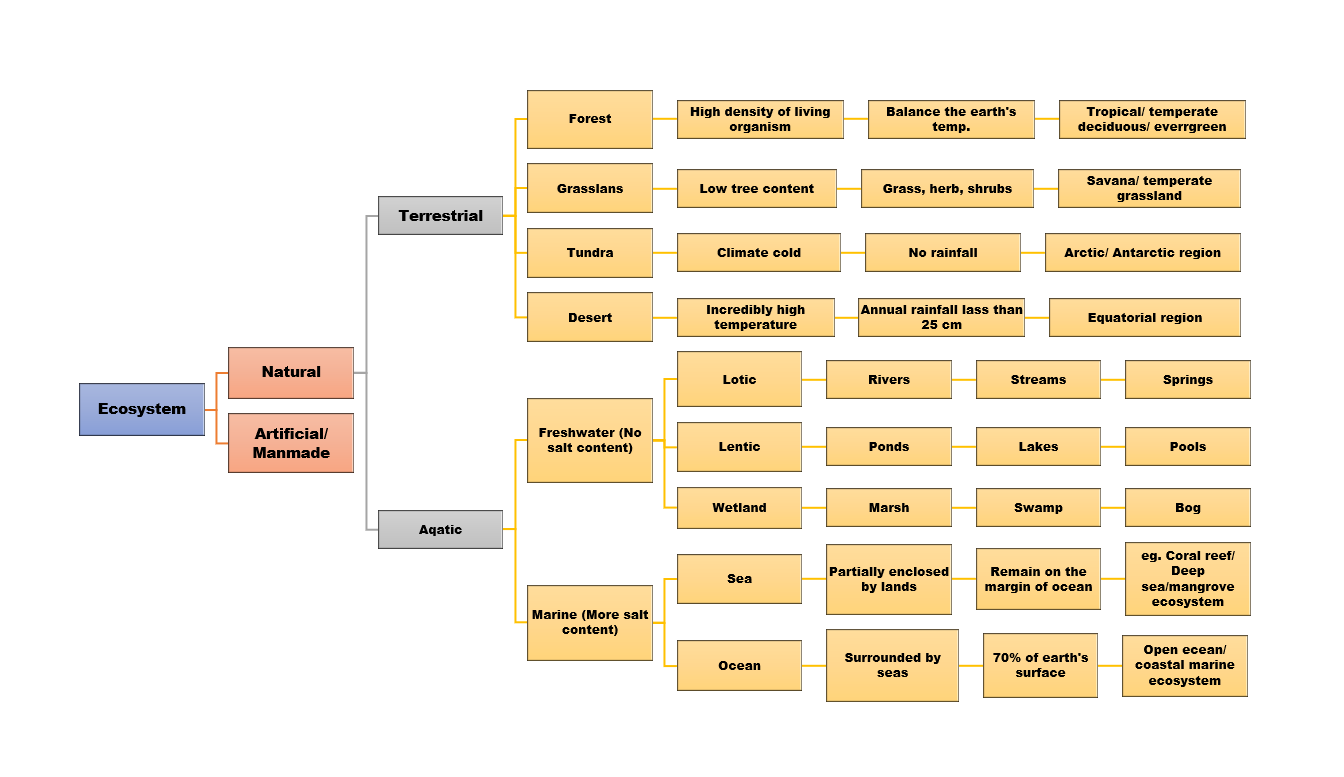
Classification of ecosystem. Source: By Author. In Bangladesh, diversity of ecosystems is noticeable. There we have rivers, lakes, grasslands, sea, forest etc. Above all this , a short idea of Bangladeshi river ecosystem will be given here.
Bangshai River Ecosystem
Before enter to the ecosystem directly, first we should know the exact area the author have worked with so that anyone of the visitors can find that place accurately for the further ecosystem study.
Bangshai River is an important river in central Bangladesh. It originates in Jamalpur, from the course of the old Brahmaputra and flows past the Madhupur tract. It flows through Tangail and meets the Tongi in Ghazipur. It passes near National Memorial in Saver and falls into the Dhaleshwari river. It is about 238 kilometres (148 mi) long. The river’s average depth is 30 feet (9 m) and maximum depth is 80 feet (24 m).
I am going to give a description about a part of the large Bangshai River ecosystem that is located at Mirzapur Upazilla in Tangail district.
Geographical description of Bangshai River: As an ecosystem is a geographical area, it has a specific value of latitude, longitude, altitude or elevation, area etc.
Latitude is the measurement of distance north or south of the Equator. It is measured with 180 imaginary lines that form circles around the Earth east-west, parallel to the Equator. These lines are known as parallels. A circle of latitude is an imaginary ring linking all points sharing a parallel.
A small area of the large Bangshai River ecosystem that I am working with, it is situated in the latitude of 24° 06′ 31” N.Longitude is the measurement east or west of the prime meridian. Longitude is measured by imaginary lines that run around the Earth vertically (up and down) and meet at the North and South Poles. These lines are known as meridians. Each meridian measures one arc-degree of longitude.
And the longitude of my nearby Bangshai River ecosystem is 90° 05′ 54” E.Altitude, like elevation, means height above the ground or above the sea level. Areas are often considered “high-altitude” if they reach at least 2,400 meters (8,000 feet) into the atmosphere. This is called indicated altitude, and is measured by an instrument called an altimeter.
Bangshai river’s altitude or elevation is 4m that means it is about 4m high in comparison of the sea level.I have took a short area to describe the ecosystem in it from the total Bangshai river that flows through many more districts.
The measurement of this area is about 122,488 m2.Total length of Bangshai river is 239 km.
From this I am working with very short length of 2 km of this area that flows past Mirzapur Upazilla, Tangail.Average width of this river is 49 m that varies in different places due to many issues like river erosion, riverside constructions, bridge riverside forest etc.
Width of Bangshai river located in Mirzapur Upazilla is 100 m on average and average depth is 9m.Location of the boundary: Generally a river ecosystem is surrounded by many things such as riverside forest ecosystem, manmade shelters, agricultural land, city ,town,village, flood-lands, graveyards, factories, many other wetlands etc.
Surrounding the boundary of Bangshai river ecosystem spot, there have-South- Slum of riverine people, Mirzapur town, Railway, Dhaka-Tangail Highway etc.
North- Floodplain lands that contains Submerged trees most commonly Akashmoni tree (Acacia), Eucalyptus, mango tree etc and many different shrubs and herbs. In northern area of the river there can be seen some brick fields, highways, roadside plants (herb,shrub,tree) and flood affected villages, some small forests.
East- A bridge named Ekabbor Bridge remains over the river in east.
West- A mosque on the riverbank, a small grassland, a river ghat.
Bangshai river in Mirzapur flows in undirected way, from west to east. Mainly it’s direction is downstream. downstream.Upazilla: Mirzapur
District: Tangail
Type of the Bangshai River Ecosystem
It is an Aquatic and Freshwater ecosystem. More specifically a River Ecosystem that is created naturally. Freshwater is a precious resource on the Earth’s surface. It is also home to many diverse fish, plant, and crustacean species. The habitats that freshwater ecosystems provide consist of lakes, rivers, ponds, wetlands, streams, and springs. River ecosystems are flowing waters that drain the landscape, and include the biotic (living) interactions amongst plants, animals and micro-organisms, as well as abiotic (nonliving) physical and chemical interactions of its many parts. River ecosystems are prime examples of lotic ecosystems. Lotic refers to flowing water, from the Latin lotus, meaning washed. Lotic waters range from springs only a few centimeters wide to major rivers kilometers in width. River ecosystems have:
- flowing water that is mostly unidirectional,
- a state of continuous physical change,
- many different (and changing) microhabitats,
- variability in the flow rates of water
- plants and animals that have adapted to live within water flow conditions.
Mainly this type of ecosystem naturally shares resources between habitats. It brings salts and nutrients from the mountains through lakes, ponds, and wetlands at lower elevations, and eventually they brings those nutrients to the ocean.
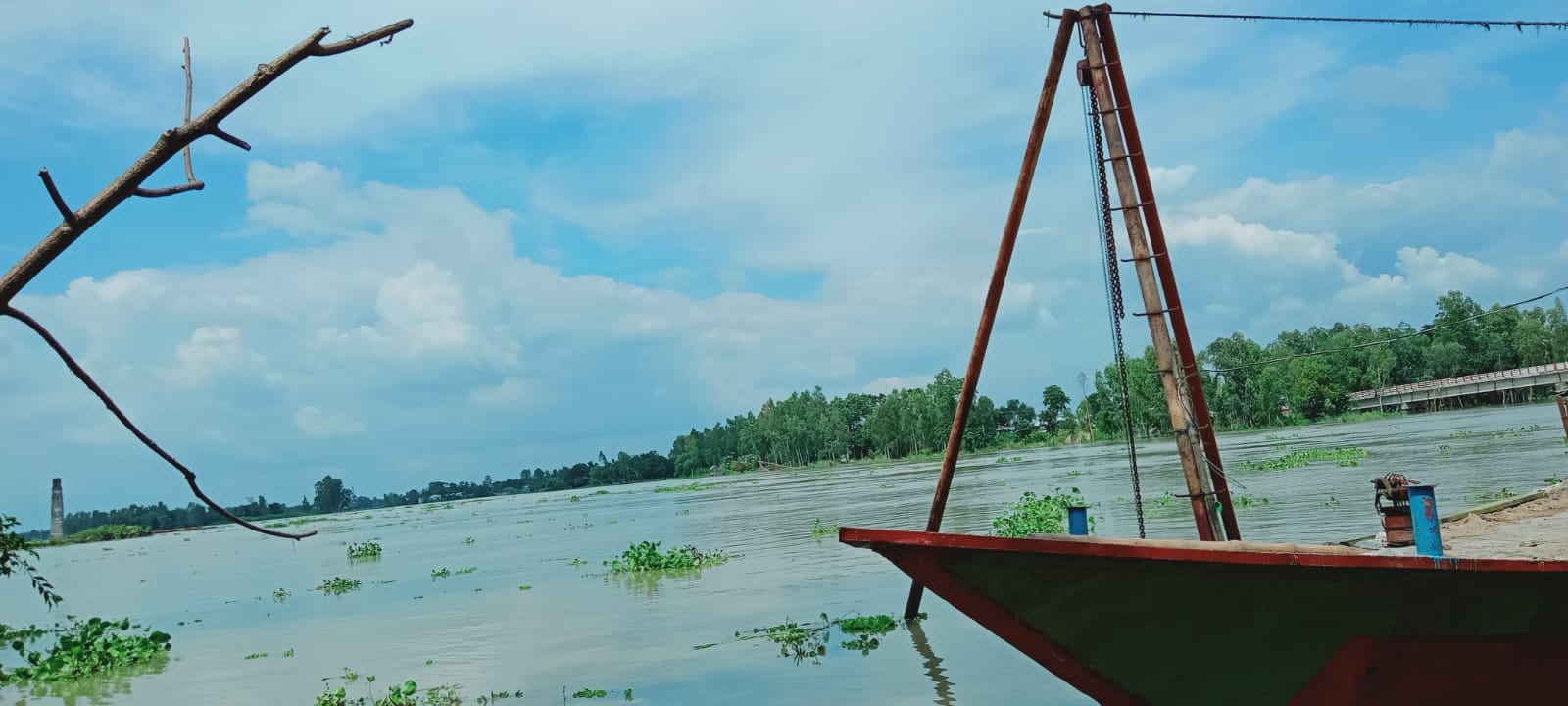
The Bangshai River, Clicked by author Components of river ecosystem
The components of an ecosystem are divided into abiotic components, that include all nonliving components and biotic components, that include all the living components. These components together make up for the flow of energy in the ecosystem and the nutrient cycle in the ecosystem.
Abiotic components
An abiotic factor is a non-living part of an ecosystem that shapes its environment. Abiotic and biotic factors work together to create a unique ecosystem. Abiotic component examples include dissolved oxygen, wind, mineral, types of soil, altitude, precipitation, salinity, temperature, pH, humidity, air, water, sunlight, mineral nutrients exist in the water, air, soil, etc.
Bangshai river ecosystem contains abiotic factors are given below-
Water flow
- Unidirectional water flow.
- Directed from west to east.
- Flow can affected by sudden water input from snowmelt, rain and groundwater.
- Water flow can alter the shape of riverbeds and creating a variety of changing habitat.
Substrate
- The substrate is the surface on which the river organisms live.
- It may be inorganic, consisting of geological material from the catchment area such as boulders, pebbles, gravel, sand or slit, or it may be organic, including fine particles, leaves, wood, moss and plants.
- Substrate is generally not permanent and is subject to large changes during flooding events.
Light
- Light provides the energy necessary to drive primary production via photosynthesis.
- Limited light limit photosynthesis.
- It can also provide refuge for prey species in shadows it casts.
- The amount of light received in a flowing waterway is variable.
- Light penetration is low in the deep river like Bangshai.
- Light affects the distribution of plants, animals in river ecosystem.
Air
- Well aerated river water gives more chance to survive for the biotic component and create more enriched ecosystem.
- The oxygen concentration of the water and the surrounding air will have great bearing on which organisms can survive in the river.
- Oxygen is required for aerobic respiration in animals.
- CO2 is required for photosynthesis, and can also affect the pH of the water.
- Nitrogen compounds in air pollution cause algal blooms, turn water bodies more acidic.
- Polluted air is more harmful for river ecosystem.
Surface tension
- The surface tension of the water will also affect the organisms that occupy the area, depending on the cohesion of water at the surface, it can affect the amount of oxygen that reaches organisms living below the water surface.
Temperature
- Most river species are poikilotherms whose internal temperature varies with their environment, thus temperature is a key abiotic factor for them.
- Deep river develop a difference of temperature in bottom and surface that determine biotic organisms to remain either top or bottom part of the river.
- The amount of shading, climate and elevation can also influence the temperature of lotic systems.
Chemistry
- The chemical compositions of the water, soil and surrounding air also play a part in determining the face of the ecosystem.
- Water chemistry in river ecosystems varies depending on which dissolved solutes and gases are present in the water column of the river
- Trace metals and pollutants.
pH
- It is the measure of hydrogen ion concentration.
- pH determines whether the river water is acidic or basic.
- Optimum pH of river water is around 7.4 but it can change depending on O2 content, pollution, ecosystem in it, surrounding environment etc.
- pH or freshwater river affects the biotic component in it.
Minerals
- River water contain dissolved inorganic matter and major ions (calcium, sodium, magnesium, potassium, bicarbonate, sulphide, chloride); dissolved inorganic nutrients (nitrogen, phosphorus, silica) and dissolved organic matter.
- Gases (nitrogen, nitrous oxide, carbon dioxide, oxygen)
- Non metallic material like sand and gravel deposits found in rivers called quartz (SiO2 ).
- Metallic resources such as tin, gold, platinum etc.
Besides these river have more abiotic factors and they are sediments, shade, depth, wind etc.
Abiotic factors affect the ability of organisms to survive and reproduce. Abiotic limiting factors restrict the growth of populations in a river ecosystem. They help determine the types and numbers of organisms able to exist within a river.
Biotic components
The living components of an ecosystem are called the biotic components. Rivers have numerous types of biotic organisms, including bacteria, primary producers, insects and other invertebrates, as well as fish and other vertebrates etc.
Within an ecosystem, biotic organisms are broken down into three main roles: producer, consumer, and decomposer. Each of these roles is extremely important in the ecosystems of freshwater biomes, as each contributes to the condition and health of the river water system.
1. Primary producer
Producers are organisms that can make all of their own food in an ecosystem. The main producers of a freshwater biome are the aquatic plants and algae. When energy enters the ecosystem as sunlight, plants and algae capture the sunlight and store it as food energy. Through the process of photosynthesis, they provide oxygen and food for animals. Algae are one of the most important producers of food for living organisms.
In Bangshai River, I found a short diversity in primary producer species, this diversity loss may be happened for many reasons that I’ll discuss at the end. Now I will enlist some of the autotrophs of Bangshai river ecosystem-
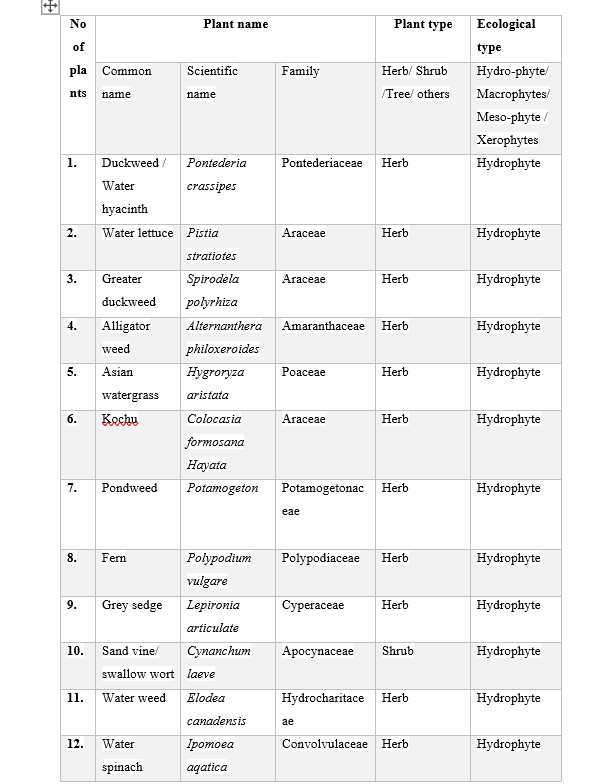
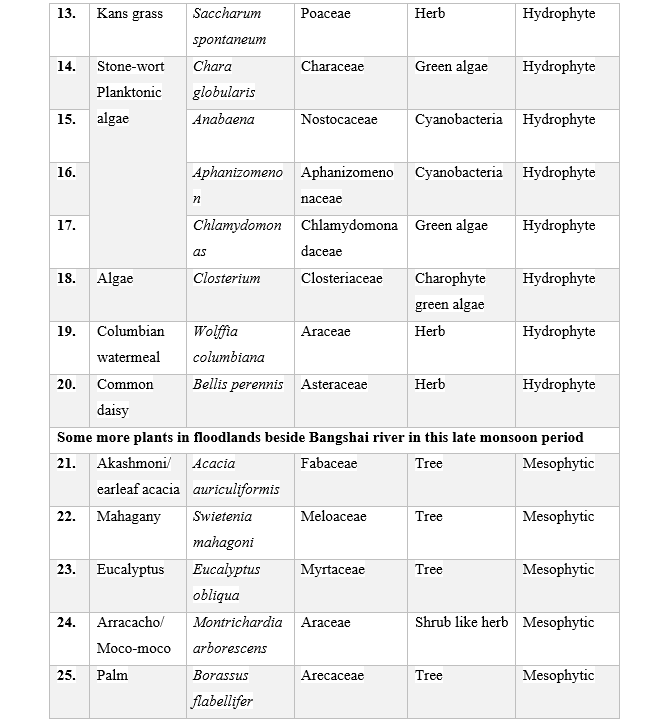
List of autotrophs in my nearby ecosystem, Source, created by Author 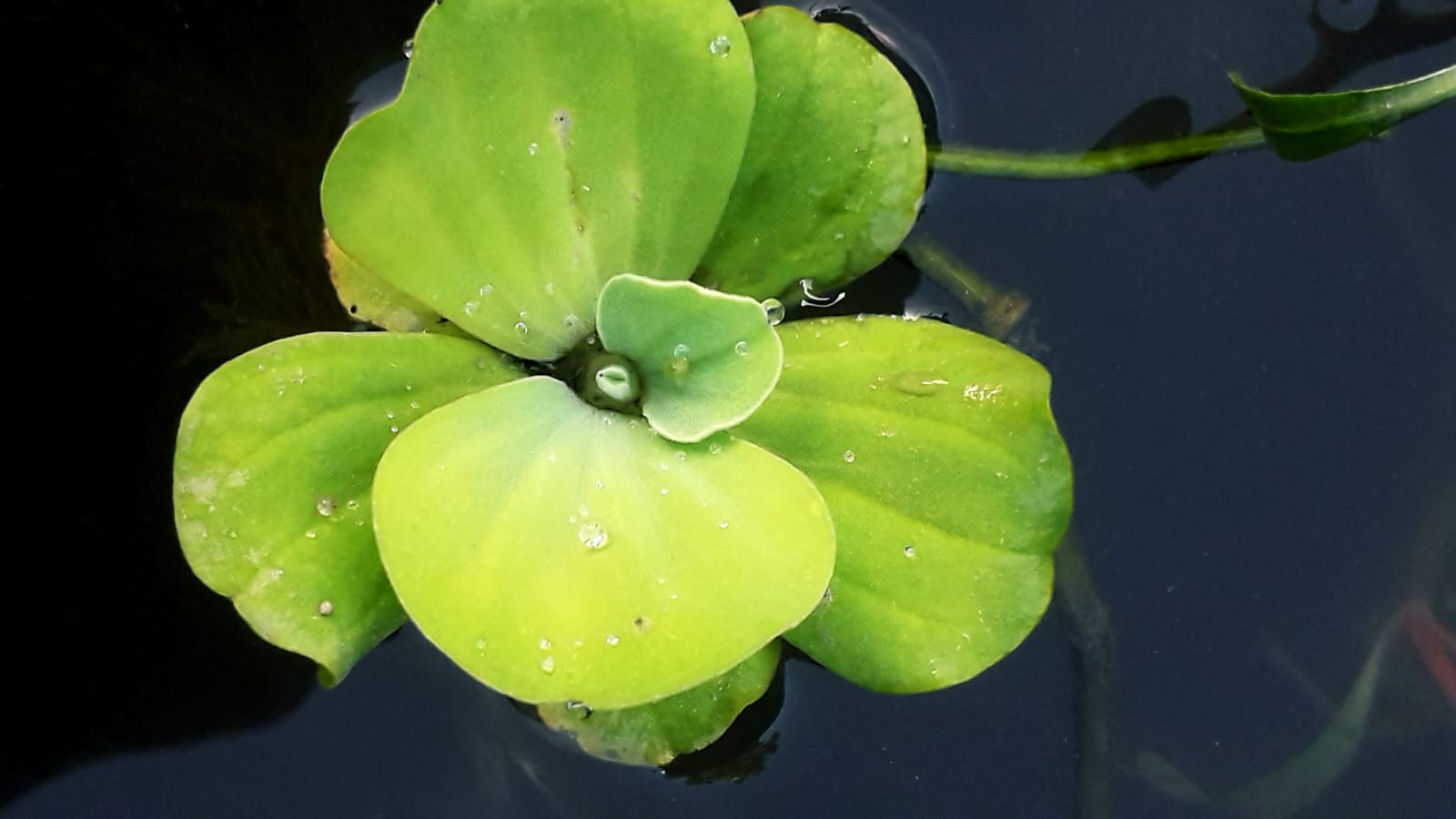
Autotrophs in river, Clicked by author
References
- Ecosystem related lecture by Professor Mohammad Zabed Hossain, Department of Botany, University of Dhaka.
- Scientific names and family name from Wikipedia.
Related Articles
 Plantlet The Blogging Platform of Department of Botany, University of Dhaka
Plantlet The Blogging Platform of Department of Botany, University of Dhaka
